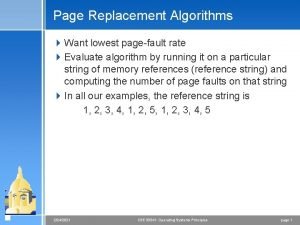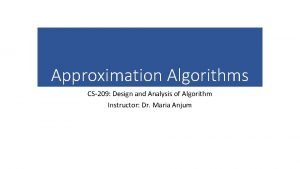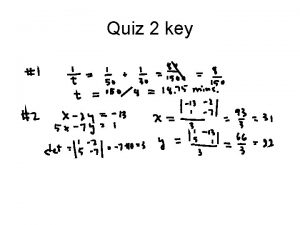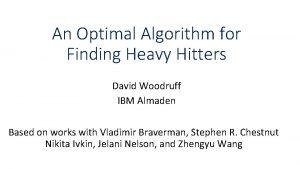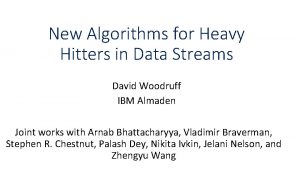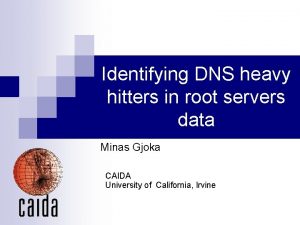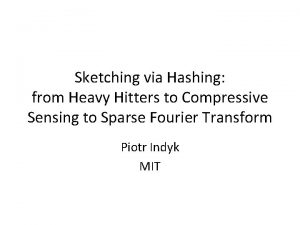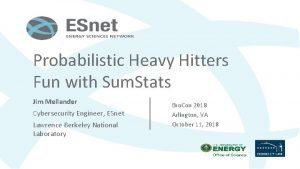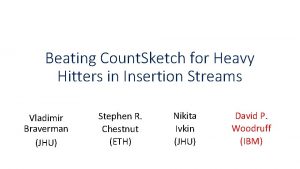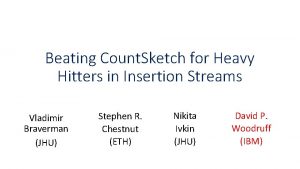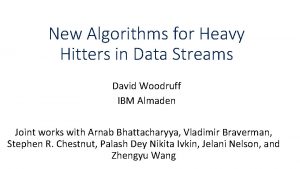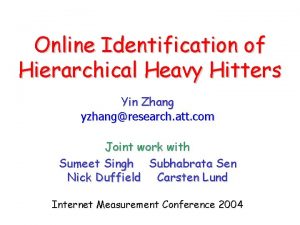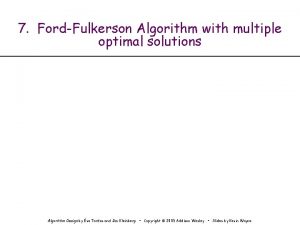An Optimal Algorithm for Finding Heavy Hitters David



![Count. Sketch achieves the l 2–guarantee [CCFC] • Assign each coordinate i a random Count. Sketch achieves the l 2–guarantee [CCFC] • Assign each coordinate i a random](https://slidetodoc.com/presentation_image_h2/be40774a12941afcedd75220f77e9431/image-4.jpg)

![Our Results [BCIW] • Our Results [BCIW] •](https://slidetodoc.com/presentation_image_h2/be40774a12941afcedd75220f77e9431/image-6.jpg)





![Chaining Inequality [Fernique, Talagrand] • Chaining Inequality [Fernique, Talagrand] •](https://slidetodoc.com/presentation_image_h2/be40774a12941afcedd75220f77e9431/image-12.jpg)





![An Optimal Algorithm [BCINWW] • Want O(log n) bits instead of O(log n) bits An Optimal Algorithm [BCINWW] • Want O(log n) bits instead of O(log n) bits](https://slidetodoc.com/presentation_image_h2/be40774a12941afcedd75220f77e9431/image-18.jpg)

- Slides: 19

An Optimal Algorithm for Finding Heavy Hitters David Woodruff IBM Almaden Based on works with Vladimir Braverman, Stephen R. Chestnut Nikita Ivkin, Jelani Nelson, and Zhengyu Wang

Streaming Model 4 3 7 3 1 1 2 … • Stream of elements a 1, …, a m in [n] = {1, …, n}. Assume m = poly(n) • Arbitrary order • One pass over the data • Minimize memory usage (space complexity) in bits for solving a task • Let fj be the number of occurrences of item j • Heavy Hitters Problem: find those j for which f j is large

Guarantees • f 1, f 2 f 3 f 4 f 5 f 6
![Count Sketch achieves the l 2guarantee CCFC Assign each coordinate i a random Count. Sketch achieves the l 2–guarantee [CCFC] • Assign each coordinate i a random](https://slidetodoc.com/presentation_image_h2/be40774a12941afcedd75220f77e9431/image-4.jpg)
Count. Sketch achieves the l 2–guarantee [CCFC] • Assign each coordinate i a random sign ¾(i) 2 {-1, 1} • Randomly partition coordinates into B buckets, maintain c j = Σi: h(i) = j ¾(i)¢fi in jth bucket f 1 f 2 f 3 . f 4 f 5 f 6 Σi: h(i) = 2 ¾(i)¢fi • Estimate fi as ¾(i) ¢ ch(i) f 7 f 8 . f 9 . f 10

Known Space Bounds for l 2– heavy hitters • Count. Sketch achieves O(log 2 n) bits of space • If the stream is allowed to have deletions, this is optimal [DPIW] • What about insertion-only streams? • This is the model originally introduced by Alon, Matias, and Szegedy • Models internet search logs, network traffic, databases, scientific data, etc. • The only known lower bound is Ω(log n) bits, just to report the identity of the heavy hitter
![Our Results BCIW Our Results [BCIW] •](https://slidetodoc.com/presentation_image_h2/be40774a12941afcedd75220f77e9431/image-6.jpg)
Our Results [BCIW] •

Simplifications •

Intuition •

• Only gives 1 bit of information. Can’t repeat log n times in parallel, but can repeat log n times sequentially!

Repeating Sequentially •

Gaussian Processes •
![Chaining Inequality Fernique Talagrand Chaining Inequality [Fernique, Talagrand] •](https://slidetodoc.com/presentation_image_h2/be40774a12941afcedd75220f77e9431/image-12.jpg)
Chaining Inequality [Fernique, Talagrand] •

a 1 a 2 a 3 a 4 a 5 • … at … am Apply the chaining inequality!

Applying the Chaining Inequality • Same behavior as for random walks!

Removing Frequency Assumptions •

Amplification • Create O(log n) pairs of streams from the input stream (stream L 1 , stream R 1), (stream L 2 , stream R 2), …, (stream Llog n , stream Rlog n ) • For each j in O(log n), choose a hash function h j : {1, …, n} -> {0, 1} • stream Lj is the original stream restricted to items i with h j(i) = 0 • stream Rj is the remaining part of the input stream • maintain counters c L = Σi: hj(i) = 0 g(i)¢fi and c R = Σi: hj(i) = 1 g(i)¢fi • (Chaining Inequality + Chernoff) the larger counter is usually the substream with i* • The larger counter stays larger forever if the Chaining Inequality holds • Run algorithm on items corresponding to the larger counts • Expected F value of items, excluding i*, is F /poly(log n), so i* is heavier

Derandomization • We have to account for the randomness in our algorithm • We need to (1) derandomize a Gaussian process (2) derandomize the hash functions used to sequentially learn bits of i* • We achieve (1) by • (Derandomized Johnson Lindenstrauss) defining our counters by first applying a Johnson-Lindenstrauss (JL) transform [KMN] to the frequency vector, reducing n dimensions to log n, then taking the inner product with fully independent Gaussians • (Slepian’s Lemma) counters don’t change much because a Gaussian process is determined by its covariances and all covariances are roughly preserved by JL • For (2), derandomize an auxiliary algorithm via Nisan’s pseudorandom generator [I]
![An Optimal Algorithm BCINWW Want Olog n bits instead of Olog n bits An Optimal Algorithm [BCINWW] • Want O(log n) bits instead of O(log n) bits](https://slidetodoc.com/presentation_image_h2/be40774a12941afcedd75220f77e9431/image-18.jpg)
An Optimal Algorithm [BCINWW] • Want O(log n) bits instead of O(log n) bits • Multiple sources where the O(log n) factor is coming from • Amplification • Use a tree-based scheme and that the heavy hitter becomes heavier! • Derandomization • Show 4 -wise independence suffices for derandomizing a Gaussian process!

Conclusions •
 Ratey algebra 2
Ratey algebra 2 Lru algorithm calculator
Lru algorithm calculator An algorithm that returns near optimal solution is called
An algorithm that returns near optimal solution is called Optimal meeting point algorithm
Optimal meeting point algorithm Euclid algorithm
Euclid algorithm Formuö
Formuö Novell typiska drag
Novell typiska drag Tack för att ni lyssnade bild
Tack för att ni lyssnade bild Vad står k.r.å.k.a.n för
Vad står k.r.å.k.a.n för Shingelfrisyren
Shingelfrisyren En lathund för arbete med kontinuitetshantering
En lathund för arbete med kontinuitetshantering Särskild löneskatt för pensionskostnader
Särskild löneskatt för pensionskostnader Tidböcker
Tidböcker Sura för anatom
Sura för anatom Vad är densitet
Vad är densitet Datorkunskap för nybörjare
Datorkunskap för nybörjare Boverket ka
Boverket ka Att skriva en debattartikel
Att skriva en debattartikel Delegerande ledarstil
Delegerande ledarstil Nyckelkompetenser för livslångt lärande
Nyckelkompetenser för livslångt lärande

